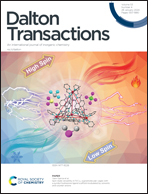The rigidity and chelation effect of ligands on the hydrogen evolution reaction catalyzed by Ni(ii) complexes†
Abstract
With increasing interest in nickel-based electrocatalysts, three heteroleptic Ni(II) dithiolate complexes with the general formula [Ni(II)L(L′)2] (1–3), L = 2-(methylene-1,1′-dithiolato)-5,5′-dimethylcyclohexane-1,3-dione and L′ = triphenylphosphine (1), 1,1′-bis(diphenylphosphino)ferrocene (DPPF) (2), and 1,2-bis(diphenylphosphino)ethane (DPPE) (3), have been synthesized and characterized by various spectroscopic techniques (UV-vis, IR, 1H, and 31P{1H} NMR) as well as the electrochemical method. The molecular structure of complex 2 has also been determined by single-crystal X-ray crystallography. The crystal structure of complex 2 reveals a distorted square planar geometry around the nickel metal ion with a NiP2S2 core. The cyclic voltammograms reveal a small difference in the redox properties of complexes (ΔE° = 130 mV) while the difference in the catalytic half-wave potential becomes substantial (ΔEcat/2 = 670 mV) in the presence of 15 mM CF3COOH. The common S^S-dithiolate ligand provides stability, while the rigidity effect of other ligands (DPPE (3) > DPPF (2) > PPh3 (1)) regulates the formation of the transition state, resulting in the NiIII–H intermediate in the order of 1 > 2 > 3. The foot-of-the-wave analysis supports the widely accepted ECEC mechanism for Ni-based complexes with the first protonation step as a rate-determining step. The electrocatalytic proton reduction activity follows in the order of complex 1 > 2 > 3. The comparatively lower overpotential and higher turnover frequency of complex 1 are attributed to the flexibility of the PPh3 ligand, which favours the easy formation of a transition state.

- This article is part of the themed collection: Celebrating International Women’s Day 2025: Women in Inorganic Chemistry


 Please wait while we load your content...
Please wait while we load your content...